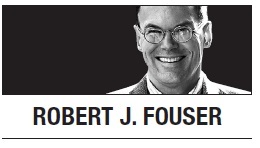[Robert Fouser] Making neighborhoods in Seoul more walkable
By Robert J. FouserPublished : June 6, 2017 - 17:37
 The much anticipated walkway over Seoul Station has opened. Called “Seoullo 7017,” the walkway fills the old overpass with greenery and offers sweeping views of the city. The name comes from the year, 1970, that the overpass was built, and the year, 2017, that the “sky garden” opened. Seoul Mayor Park Won-soon decided to turn the aging overpass into a park-like walkway to connect areas of the city around Seoul Station. The city sponsored an international competition and awarded the contract to the Dutch architectural firm MVRDV.
The much anticipated walkway over Seoul Station has opened. Called “Seoullo 7017,” the walkway fills the old overpass with greenery and offers sweeping views of the city. The name comes from the year, 1970, that the overpass was built, and the year, 2017, that the “sky garden” opened. Seoul Mayor Park Won-soon decided to turn the aging overpass into a park-like walkway to connect areas of the city around Seoul Station. The city sponsored an international competition and awarded the contract to the Dutch architectural firm MVRDV. Since its opening, Seoullo 7017 has attracted large crowds and media attention. The crowds have seemed pleased and media reports have been largely favorable. Critics, however, argue the walkway stimulates gentrification and does little for residents in nearby neighborhoods. All sides in the debate acknowledge the project has brought new life to the Seoul Station area.
Shortly after Seoullo 7017 opened, the city announced plans to close the street on both sides of the Gwanghwamun Plaza and turn the entire area into a pedestrian plaza. To test the idea, the city closed the streets off to traffic on the weekend of June 3. The move attracted large crowds, which should encourage the city to move ahead with the plans.
Closing streets off to traffic in Seoul is not new. From 1985 to 1989, Daehangno was closed to traffic on weekends, but the policy was dropped because of traffic congestion. Nearby Insa-dong, meanwhile, has been closed to cars on weekends since 1997. In 2005, the elevated highway and road over Cheonggye Stream were torn down and the stream was turned into a walking course. Streets in other areas in Seoul have been closed to traffic for special events.
And Seoul is not the only city to close off streets to traffic on weekends or for special events. Tokyo, for example, began closing off the main street in Ginza to traffic on weekend afternoons. Most European cities close off parts of historic city centers to traffic. European cities that close off large areas to traffic allow limited access for service vehicles.
In many ways, Seoul is behind its peers in turning streets into pedestrian zones. Most old areas of the city have narrow streets, but few are closed off to traffic permanently. Cars and people often compete for space in narrow streets.
Seoullo 7017 and plans for Gwanghwamun are important steps forward in making Seoul more walkable. Like the Cheonggye Stream, they are large, high-profile projects that turn major traffic arteries into walkable spaces. They also reflect a strong desire to create landmarks and green spaces in the city.
To be sure, urban landmarks and green space are good things. Landmarks give the city a visual identity that can be used to brand and market the city. They also reflect the values of the time in which they were created, which gives the cityscape a sense of history.
Green space, meanwhile, comes in all sizes. Famous parks, such as New York’s Central Park, become landmarks of their own. On the other extreme are pot gardens that line alleyways in old areas in cities in Korea and Japan. Tree-lined streets and pocket parks are popular types of green spaces.
Instead of focusing its attention on landmarks, Seoul needs to go micro and turn its attention to small spaces. A quick look at Seoul from a satellite map reveals a city of concrete with considerable green space in the mountains found throughout the city. The mountains are a major asset for Seoul, but for most residents they are weekend destinations.
Apart from a few areas of the city with single-family houses, housing in Seoul falls into two main categories: Apartment complexes and small-scale multifamily units. Apartment complexes are required to provide green space, but it is limited to residents. Multifamily units were built on small lots designed for single-family houses. They are usually packed closely together leaving no space for greenery or sidewalks.
A first step toward shifting priorities would be to abandon plans to turn Gwanghwamun into a pedestrian plaza. Closing the area on weekends is an inexpensive way to increase walkability and enhance what is already a landmark.
The money saved could then be used for experiments that increase green spaces and walkability in the concrete jungle where people live. Better sidewalks, pocket parks and weekend street closings of local shopping areas are all inexpensive ways to improve neighborhoods. More importantly, they will help people feel the benefits of walkability which will, in turn, lessen the development-era attachment to the automobile that informs so many debates about the use of space.
By Robert J. Fouser
Robert J. Fouser, a former associate professor of Korean language education at Seoul National University, writes on Korea from Pawtucket, Rhode Island. He can be reached at robertjfouser@gmail.com. -- Ed.








![[Graphic News] More Koreans say they plan long-distance trips this year](http://res.heraldm.com/phpwas/restmb_idxmake.php?idx=644&simg=/content/image/2024/04/17/20240417050828_0.gif&u=)
![[KH Explains] Hyundai's full hybrid edge to pay off amid slow transition to pure EVs](http://res.heraldm.com/phpwas/restmb_idxmake.php?idx=644&simg=/content/image/2024/04/18/20240418050645_0.jpg&u=20240419100350)





![[From the Scene] Monks, Buddhists hail return of remains of Buddhas](http://res.heraldm.com/phpwas/restmb_idxmake.php?idx=652&simg=/content/image/2024/04/19/20240419050617_0.jpg&u=20240419175937)

![[KH Explains] Hyundai's full hybrid edge to pay off amid slow transition to pure EVs](http://res.heraldm.com/phpwas/restmb_idxmake.php?idx=652&simg=/content/image/2024/04/18/20240418050645_0.jpg&u=20240419100350)

![[Today’s K-pop] Illit drops debut single remix](http://res.heraldm.com/phpwas/restmb_idxmake.php?idx=642&simg=/content/image/2024/04/19/20240419050612_0.jpg&u=)